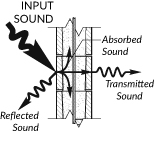Sound Insulation
 There are two properties of concrete masonry that make it useful as a noise-controlling material. The first characteristic is its effectiveness as a sound barrier that reflects sound waves. The second property is its ability to absorb sound and further minimize the sound that is transmitted through a concrete masonry wall. As shown in Figure 1, both of these characteristics combine to make concrete masonry extremely effective in preventing sound transmission over a wide range of frequencies.
There are two properties of concrete masonry that make it useful as a noise-controlling material. The first characteristic is its effectiveness as a sound barrier that reflects sound waves. The second property is its ability to absorb sound and further minimize the sound that is transmitted through a concrete masonry wall. As shown in Figure 1, both of these characteristics combine to make concrete masonry extremely effective in preventing sound transmission over a wide range of frequencies.
Sound absorption is particularly important in auditoriums, concert halls and other locations where noise reflection needs to be minimized to control the sound generated within a room. The sound absorption coefficient defines how effectively a surface absorbs noise. A sound absorption coefficient of 0.25 indicates that 25% of the sound striking the surface is absorbed by the wall at the frequency being considered. The noise reduction coefficient (NRC) is the average of the sound absorption coefficient at frequencies of 250, 500, 1000 and 2000 hertz. Table 2.6.1 provides the approximate values of the NRC for some concrete masonry walls. The table shows that lighter material is more efficient in absorbing sound waves. Application of paint and other finishes to concrete masonry typically reduces the NRC value by increasing the amount of sound reflected by the wall.
 Fire Resistive Ratings
Fire Resistive Ratings

